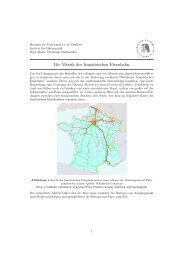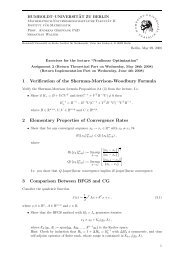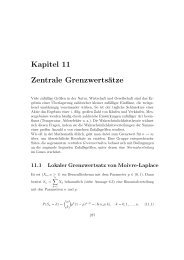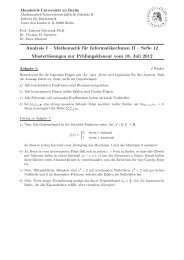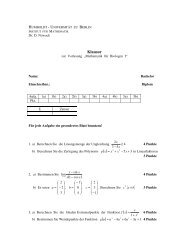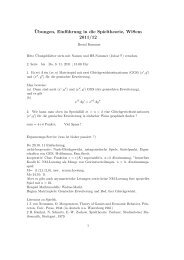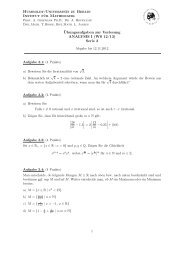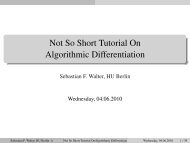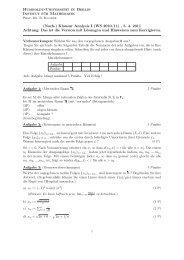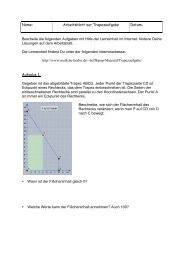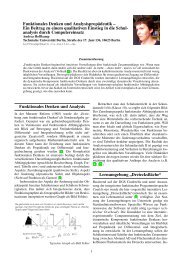Einführung in die Maß- und Integrationstheorie
Einführung in die Maß- und Integrationstheorie
Einführung in die Maß- und Integrationstheorie
Sie wollen auch ein ePaper? Erhöhen Sie die Reichweite Ihrer Titel.
YUMPU macht aus Druck-PDFs automatisch weboptimierte ePaper, die Google liebt.
Dann istϕ ′ (t) = 1 p − 1 p t 1 p −1 = 1 p(1 − 1 ) { > 0 falls t ∈ (1, ∞)t 1− 1 p < 0 falls t ∈ (0, 1)Die Funktion ϕ ist somit monoton wachsend auf (1, +∞) <strong>und</strong> monoton fallend auf (0, 1).Da ϕ(1) = 1 p + 1 q − 1 = 0, ist ϕ ≥ 0 auf (0, +∞). Wir setzen nun t := a b, a, b > 0. Dann folgtd.h.1p · ab + 1 ( a) 1q − p≥ 0bap + b q ≥ a 1 p · b1− 1 p= a 1 p · b1q .Falls ‖f‖ p = 0 oder ‖h‖ q = 0 gilt, so folgt f = 0 oder h = 0 µ-fast überall <strong>und</strong> somit<strong>die</strong> Behauptung des Satzes unmittelbar. Wir können also annehmen, dass ‖f‖ p > 0 <strong>und</strong>‖h‖ q > 0 gilt.Im Fall K = R <strong>und</strong> K = C s<strong>in</strong>d <strong>die</strong> Werte |f(x)| p <strong>und</strong> |h(x)| q für jedes x ∈ X endlich. ImFalle K = ¯R gilt <strong>die</strong>s nach Satz 11.27 für µ-fast alle x ∈ X, dh. auf e<strong>in</strong>er Menge X 0 ⊂ X, <strong>die</strong>sich von X nur durch e<strong>in</strong>e Nullmenge unterscheidet. Wir können also weiterh<strong>in</strong> annehmen,dassWir setzen nun für x ∈ X 0 <strong>in</strong> (∗)|f(x)| p < ∞ <strong>und</strong> |h(x)| q < ∞ ∀x ∈ X 0 .a := |f(x)|p‖f‖ p p<strong>und</strong>b := |h(x)|q‖h‖ q q.Dann folgt|f(x)|‖f‖ p· |h(x)|‖h‖ q≤ 1 p|f(x)| p‖f‖ p p+ 1 q|h(x)| q‖h‖ q qIntegrieren wir <strong>die</strong>s über X 0 (bzw. über <strong>die</strong> sich von X 0 nur durch e<strong>in</strong>e Nullmenge unterscheidendeMenge X), so erhalten wir∫1·‖f‖ p · ‖h‖ qX|f(x) · h(x)| dµ ≤ 1 ∫p · 1‖f‖ p |f(x)| p dµ(x) + 1pq · 1‖h‖ q qX= 1 p + 1 q = 1.∫·X|h(x)| q dµ(x)<strong>und</strong> somit‖f · h‖ 1 ≤ ‖f‖ p · ‖h‖ q .Satz 11.43 (M<strong>in</strong>kowski-Ungleichung). Sei 1 ≤ p < ∞ <strong>und</strong> seien f, h ∈ L p . Dann giltf + h ∈ L p <strong>und</strong>‖f + h‖ p ≤ ‖f‖ p + ‖h‖ p(M<strong>in</strong>kowski-Ungleichung)d.h.) 1 ( ∫|f + h| p pdµ ≤X) 1 ( ∫|f| p pdµ +X) 1|h| p pdµ.( ∫ X65



